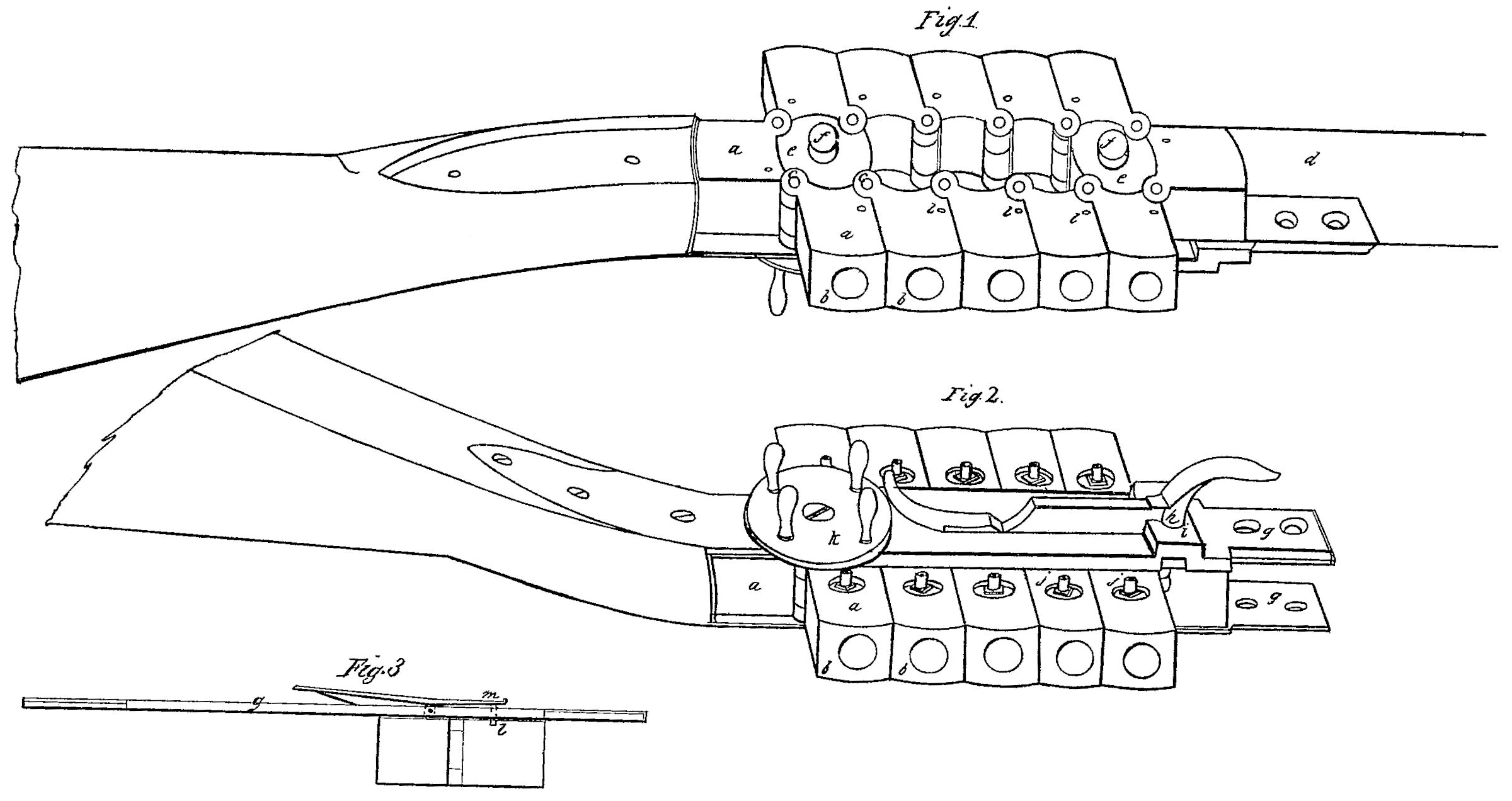US 603
UNITED STATES PATENT OFFICE.
E. A. BENNETT AND F. P. HAVILAND, OF WATERVILLE, MAINI; SAID HAVIIAND ASSIGNOR TO AMASA PAINE.
IMPROVEMENT IN THE CONSTRUCTION OF MANY-CHAMBERED FIRE-ARMS.
Specification forming part of Letters Patent, No. 608 dated February 16, 1838.
To all whom it may concern:
Be it known that we, Epenetus A. Bennett and Frederick P. Haviland, of Waterville, in the county of Kennebec and State of Maine, have invented an improved mode of constructing fire-arms of various descriptions by means of Which many successive discharges may be made in rapid succession and we do hereby declare that the following is a full description thereof.
We propose a number of blocks of steel or other metal of such size as may be necessary for the formation of a chamber in each block to receive a Single charge, which will of course vary with the caliber of the fire-arm to be made. These blocks are to be cut from square bars, and are to be connected together by hinge-joints, so as to form at endless chain of chambers, as hereinafter explained, and represented in the drawings accompanying this specification.
Figure 1 represents the endless chain of chambers, and the revolving standards by which the endless chain is sustained and moved, so that the chambers may be caused successively to coincide With the bore of the barrel, a part of which, also, is represented. In this figure all the other parts are omitted for the sake of clearness of description. a a are the blocks which constitute the revolving chain, the openings of the chambers being seen at b b. The joints or hinges by which they are connected are shown at c c c. A part of the barrel of the gun is shown at d. there are two revolving standards, e e, having pivots f f at each of their ends, which are received into and revolve in corresponding holes in the straps by which the barrel and the stock are connected together above and below, and between which the chambers revolve. The back of each chamber bears against one of these standards at the time of discharge, preventing the recoil of the chamber.
Fig. 2 shows the under side of the chain of chambers, with a portion of the lock and other parts connected therewith, the same letters being used in Fig. 1, where like parts are represented. The straps g g’ connect the barrel and stock, and that lettered g’ has the lock attached to it. The hammer h strikes through the hole hole i upon a percussion-cap, each block being furnished with a nipple, j j, to receive such cap. In the construction of the lock there is not any peculiarity upon which we intend to found a claim. The plate k is attached to the pivot of one of the standards, and has pins projecting from it by which to turn it with facility, so as to bring a new chamber into proper place after discharge, which is done by turning the plate it, and raising a spring-catch, m, Which falls into the holes l l l on the opposite side of the chambers, and shown in Fig. 1, said spring-catch, Fig. 3, being fixed on the strap g and falling into the holes l l When the chamber and bore coincide.
We have devised modes of cocking the gun by the same movement, which brings the chambers into place, and intend sometimes to construct our guns with this appendage, varying this and other parts as we may think proper, while We preserve the main features of our invention, and upon which our claim is founded. This claim consists in the construction of an endless chain of chambers connected together by hinged joints, arranged and operating substantially in the way herein described, and represented in the accompanying drawings. We use metallic plates to cover the percussion caps on each side of the stock-straps g, and the whole of the endless chain of chambers may, if preferred, be surmounted by a suitable case.
E. A. BENNETT.
F. P. HAVILAND,
Witnesses to the signature of B. A. Bennett:
P. I. K. Morsell,
Linton Thorn.
Witnesses to the signature of F. P. Haviland:
W. B. S. Moor,
William Moor.

